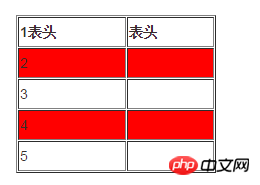Home >Web Front-end >JS Tutorial >The difference between jquery :even and :odd selectors
The difference between jquery :even and :odd selectors
- 黄舟Original
- 2017-06-23 09:56:095867browse
:even Even-numbered matching elements within the page range
Then:nth-child(even) means the even-numbered elements starting from 1st, and :even means the even-numbered elements starting from 0th
A common example in practice is that when setting the color change for even-numbered rows of a table, you can skip the header row and set it from row 1.
Let's look at an actual For example, set the background color of the even-numbered rows of the table to red and see the different results of the two writing methods
Use:nth-child(even)
Code:
$('table tr:nth-child(even)').css('background-color','red');
The effect is as shown below:

Use:even
Code:
$('table tr:even').css('background-color','red');
The effect is as shown below:

jquery How to use the odd and even selector of variables
$(function(){
$("#cate_list:odd").addClass('single');
$("#cate_list:even").addClass('double'); });How to change .cate_list to a variable?
Tried
$(function(){
var id="cate_list";
$("#"+id).addClass('single');
});Usage instructions for the odd and even selectors in jquery
: The odd selector selects each element with an odd index value (such as 1, 3, 5).
index values start from 0, all first elements are even numbers (0).
The most common usage: used with other elements/selectors to select odd-numbered elements in a specified group (such as the example above).
Syntax
$(":odd")For example: $("tr:odd") means to get odd-numbered rows
Similarly,
$("tr:even") means to get even-numbered rows.
even: Control odd line style.
Example:
<html xmlns="http://www.w3.org/1999/xhtml">
<head>
<title>无标题页</title>
<script type="text/javascript" src="Script/jQuery-1.3.2.min.js"></script>
<style type="text/css">
.old
{
background-color: red;
}
.even
{
background-color: Fuchsia;
}
</style>
<script type="text/javascript">
$(document).ready(
function(){
$("tr:old").addClass("old");
$("tr:even").addClass("even");
//$("td:contains('第五学期')").addClass("tdfont");
}
);
</script>
</head>
<body>
<table cellpadding="0" cellspacing="0" border="0">
<tr>
<td>
第一学期
</td>
<td>
</td>
<td>
</td>
</tr>
<tr>
<td>
第二学期
</td>
<td>
</td>
<td>
</td>
</tr>
<tr>
<td>
第三学期
</td>
<td>
</td>
<td>
</td>
</tr>
<tr>
<td>
第四学期
</td>
<td>
</td>
<td>
</td>
</tr>
<tr>
<td>
第五学期
</td>
<td>
</td>
<td>
</td>
</tr>
</table>
</body>
</html>The above is the detailed content of The difference between jquery :even and :odd selectors. For more information, please follow other related articles on the PHP Chinese website!
Related articles
See more- An in-depth analysis of the Bootstrap list group component
- Detailed explanation of JavaScript function currying
- Complete example of JS password generation and strength detection (with demo source code download)
- Angularjs integrates WeChat UI (weui)
- How to quickly switch between Traditional Chinese and Simplified Chinese with JavaScript and the trick for websites to support switching between Simplified and Traditional Chinese_javascript skills

